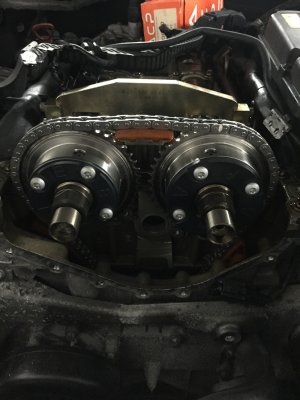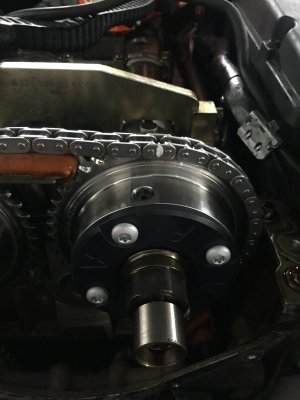Garages tell people all sorts !And for what it's worth... it is not actually a 'Mitsubishi engine' - the basic design is indeed based on a similar Mitsubishi engine, but the M271 was developed and manufactured by Mercedes Benz.
Navigation
Install the app
How to install the app on iOS
Follow along with the video below to see how to install our site as a web app on your home screen.
Note: This feature may not be available in some browsers.
More options
C180 K timing chain and sprocket kit
- Thread starter Momo220
- Start date
ampwhu
Active Member
so if I aim for a 2013 onwards, I will avoid this trouble. sound advice there.
thanks
thanks
- Joined
- Jun 24, 2008
- Messages
- 51,635
- Location
- London
- Car
- 2025 Hyundai IONIQ 5 N-Line S RWD / 2016 Suzuki Vitara 1.6L Petrol AWD
...just make sure it's the M274 engineso if I aim for a 2013 onwards, I will avoid this trouble. sound advice there.
thanks

Old spanners
Active Member
- Joined
- Apr 15, 2017
- Messages
- 134
- Car
- W203 C180K
Looks like this problem effects the CGI 271 engine and not the earlier 271 kompressor engine ....just make sure it's the M274 engine
- Joined
- Jun 24, 2008
- Messages
- 51,635
- Location
- London
- Car
- 2025 Hyundai IONIQ 5 N-Line S RWD / 2016 Suzuki Vitara 1.6L Petrol AWD
From what I read... the earlier Kompressor engines suffered from timining gear failure at around the 100k miles mark. MB modified the timing chain for the Turbocharged CGI engines, but the modified chain is prone to failing at around 30k-40k miles... so ultimately all M271 engines are affected. Said that, there are many W203 and W204 out there with perfectly healthy M271 engines, so it's the luck of the draw.Looks like this problem effects the CGI 271 engine and not the earlier 271 kompressor engine .
Old spanners
Active Member
- Joined
- Apr 15, 2017
- Messages
- 134
- Car
- W203 C180K
Doesn't really inspire confidence in the M271 petrol engines used in the W203/4 and makes changing a timing belt every 40K look cheap and easy.From what I read... the earlier Kompressor engines suffered from timining gear failure at around the 100k miles mark. MB modified the timing chain for the Turbocharged CGI engines, but the modified chain is prone to failing at around 30k-40k miles... so ultimately all M271 engines are affected. Said that, there are many W203 and W204 out there with perfectly healthy M271 engines, so it's the luck of the draw.
Once they reverted to single row chain in pursuit of reduced frictional losses the advantage of a chain over a belt was lost as the chains last no longer but cost 10 times as much to replace. Owners would sleep easier knowing only a belt change was needed at modest cost.
Even though they can no longer engineer a chain drive properly MB seem to turn their nose up at belts. Has their ever been an MB engine with a belt ?
Even though they can no longer engineer a chain drive properly MB seem to turn their nose up at belts. Has their ever been an MB engine with a belt ?
- Joined
- Jun 24, 2008
- Messages
- 51,635
- Location
- London
- Car
- 2025 Hyundai IONIQ 5 N-Line S RWD / 2016 Suzuki Vitara 1.6L Petrol AWD
...Has their ever been an MB engine with a belt ?
As far as I know, only the Renault Diesel engine in the A-Class.
- Joined
- Jun 24, 2008
- Messages
- 51,635
- Location
- London
- Car
- 2025 Hyundai IONIQ 5 N-Line S RWD / 2016 Suzuki Vitara 1.6L Petrol AWD
Interesting discussion here:
Mercedes-Benz A-Class - Renault engine! | Motoring discussion | Back Room Forum | Honest John
Mercedes-Benz A-Class - Renault engine! | Motoring discussion | Back Room Forum | Honest John
- Joined
- Jun 24, 2008
- Messages
- 51,635
- Location
- London
- Car
- 2025 Hyundai IONIQ 5 N-Line S RWD / 2016 Suzuki Vitara 1.6L Petrol AWD
I could live with a belt change at 72000 miles. As was pointed out that's only one change in the life time of the vehicle in many cases.
I had an Omega for 4 years, another Omega for 7 years, and a Scenic II for 5 years.
Each car had the timing belt replaced once during my ownership. I doubt these belts got replaced again before the cars perished.
- Joined
- Jun 24, 2008
- Messages
- 51,635
- Location
- London
- Car
- 2025 Hyundai IONIQ 5 N-Line S RWD / 2016 Suzuki Vitara 1.6L Petrol AWD
I did have a belt go on a 1.8L Diesel Escort.... and wrecked the engine. It was a company car I was driving at the time (well over 20 years ago...) so I am not sure how well it was maintained.
- Joined
- Feb 8, 2007
- Messages
- 20,827
- Location
- Portsmouth, Hampshire.
- Car
- E55K SL500 E250X2 Smart44 Brabus Track car E450Cabriolet X350 Pick up
Most of teh causes of the chain wearing is lack of oil top ups. They do use oil and its very low when the light comes on.
MrC200K
New Member
I had the same problem a year ago with my C200K but I didnt want to order FAI. I had a Navara and my FAI timing chain lasted ~7000 miles before it snapped. BGA and genuine Mercedes stuff seemed just too expensive.
I ordered the timing chain kit and these cam sprockets from here: Mercedes Benz C180K C200 M271 Timing chain kit
After a year everything is ok and no quality issues. My wife loves the car so I think we keep it for a while. At some point every make has some issues.
I ordered the timing chain kit and these cam sprockets from here: Mercedes Benz C180K C200 M271 Timing chain kit
After a year everything is ok and no quality issues. My wife loves the car so I think we keep it for a while. At some point every make has some issues.
I have had a timing belt go on a Mark 3 Cortina,but as it was a over square 2 litre engine it did not wreck the engine as it would have had it been the 1.6 I agree most belts only need changing once in the life of the car,well most cars.
grober
MB Master
If belts are good enough for Ferrari and other multi-cylinder exotics that rev to 6,000 plus- I reckon if you change em at regular intervals------ etc etc

Part of the problem now stems from engine accessibility. Power plants are now hung with a plethora of emission/power related devices egrs turbos precats/filters etc assembled at the engine plant--- they are then "shoehorned" into increasingly compact engine compartments for packaging/safety reasons making routine service operations far more time consuming- particularly true of fwd models.
Manufacturers should adopt a far more modular approach at the design stage allowing easy complete power plant removal for servicing--- quick connect devices for all engine main services/connections and a drop down engine module /frame to allow factory type access to all engine components. This servicing accessibility disadvantage is going to become more apparent as electric powered cars with their reduced servicing profiles make more of an impact on the market.

Part of the problem now stems from engine accessibility. Power plants are now hung with a plethora of emission/power related devices egrs turbos precats/filters etc assembled at the engine plant--- they are then "shoehorned" into increasingly compact engine compartments for packaging/safety reasons making routine service operations far more time consuming- particularly true of fwd models.
Manufacturers should adopt a far more modular approach at the design stage allowing easy complete power plant removal for servicing--- quick connect devices for all engine main services/connections and a drop down engine module /frame to allow factory type access to all engine components. This servicing accessibility disadvantage is going to become more apparent as electric powered cars with their reduced servicing profiles make more of an impact on the market.
- Joined
- Jun 24, 2008
- Messages
- 51,635
- Location
- London
- Car
- 2025 Hyundai IONIQ 5 N-Line S RWD / 2016 Suzuki Vitara 1.6L Petrol AWD
I think that another key differentiator is that a belt can go at any time with no warning - in most cases the giveaway signs of imminent failure will require visual inspection, which most owners don't often do. Hence why belts are changed pre-emptively at given intervals.
A failing chain tends to give plenty of notice by becoming loud and rattling many miles begore it will actually fail. But sadly many owners tend to ignore these warning signs...
A failing chain tends to give plenty of notice by becoming loud and rattling many miles begore it will actually fail. But sadly many owners tend to ignore these warning signs...
Lots of years ago when faced with a big V8 engines and a belt change we used to cut the belt on the top pulley using a sharp stanley knife,you got the engine idling then carefully found the centre of the belt and pressed down with the knife cutting the belt along the middle , then you stopped the engine,you then released the tension on the belt slid off the outer half and put the new belt on halfway then you cut the inner bit of belt and put the new belt on completely then put the belt under tension and started the engine up,new belt fitted no problem with timing.
Users who are viewing this thread
Total: 1 (members: 0, guests: 1)
Similar threads
- Replies
- 0
- Views
- 176


